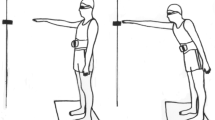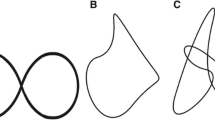Abstract
Limb proprioception is an awareness by the central nervous system (CNS) of the location of a limb in three-dimensional space and is essential for movement and postural control. The CNS uses the position of the head and neck when interpreting the position of the upper limb, and altered input from neck muscles may affect the sensory inputs to the CNS and consequently may impair the awareness of upper limb joint position. The purpose of this study was to determine whether fatigue of the cervical extensors muscles (CEM) using a submaximal fatigue protocol alters the ability to recreate a previously presented elbow angle with the head in a neutral position. Twelve healthy individuals participated. CEM activity was examined bilaterally using surface electromyography, and kinematics of the elbow joint was measured. The fatigue protocol included an isometric neck extension task at 70 % of maximum until failure. Joint position error increased following fatigue, demonstrating a significant main effect of time (F 2, 18 = 19.41, p ≤ 0.0001) for absolute error. No significant differences were found for variable error (F 2, 18 = 0.27, p = 0.76) or constant error (F 2, 18 = 1.16 of time, p ≤ 0.33). This study confirms that fatigue of the CEM can reduce the accuracy of elbow joint position matching. This suggests that altered afferent input from the neck subsequent to fatigue may impair upper limb proprioception.








Similar content being viewed by others
References
Abramowitz M, Stegun IA (2012) Handbook of mathematical functions: with formulas, graphs, and mathematical tables. Courier Dover Publications, US
Allen T, Proske U (2006) Effect of muscle fatigue on the sense of limb position and movement. Exp Brain Res 170(1):30–38
Allen TJ, Ansems GE, Proske U (2007) Effects of muscle conditioning on position sense at the human forearm during loading or fatigue of elbow flexors and the role of the sense of effort. J Physiol 580(2):423–434
Barker I (2011) Alterations in neck muscle performance and proprioception with fatique, altered posture and recurrent neck pain. Masters thesis, Faculty of Health Sciences, University of Ontario Institute of Technology (UOIT). https://ir.library.dc-uoit.ca/bitstream/10155/189/1/Barker_Ian.pdf
Bilodeau M, Henderson TK, Nolta BE, Pursley PJ, Sandfort GL (2001) Effect of aging on fatigue characteristics of elbow flexor muscles during sustained submaximal contraction. J Appl Physiol 91(6):2654–2664
Bolton PS (1998) The somatosensory system of the neck and its effects on the central nervous system. J Manip Physiol Ther 21(8):553–563
Brockett C, Warren N, Gregory J, Morgan D, Proske U (1997) A comparison of the effects of concentric versus eccentric exercise on force and position sense at the human elbow joint. Brain Res 771(2):251–258
Carpenter JE, Blasier RB, Pellizzon GG (1998) The effects of muscle fatigue on shoulder joint position sense. Am J Sports Med 26(2):262–265
Cohen LA (1961) Role of eye and neck proprioceptive mechanisms in body orientation and motor coordination. J Neurophysiol 24:1–11
De Luca CJ (1983) Myoelectrical manifestations of localized muscular fatigue in humans. Crit Rev Biomed Eng 11(4):251–279
De Luca CJ (1997) The use of surface electromyography in biomechanics. J Appl Biomech 13:135–163
Dover G, Powers ME (2003) Reliability of joint position sense and force-reproduction measures during internal and external rotation of the shoulder. J Athl Train 38(4):304–310
Enoka RM, Duchateau J (2008) Muscle fatigue: what, why and how it influences muscle function. J Physiol 586(1):11–23
Fortier S, Basset FA, Billaut F, Behm D, Teasdale N (2010) Which type of repetitive muscle contractions induces a greater acute impairment of position sense? J Electromyogr Kinesiol 20(2):298–304
Gear WS (2011) Effect of different levels of localized muscle fatigue on knee position sense. J Sports Sci Med 10(4):725
Gregory JE, Morgan DL, Proske U (1988) Aftereffects in the responses of cat muscle spindles and errors of limb position sense in man. J Neurophysiol 59(4):1220–1230
Gregory J, Morgan D, Proske U (2004) Responses of muscle spindles following a series of eccentric contractions. Exp Brain Res 157(2):234–240
Grigg P (1994) Peripheral neural mechanisms in proprioception. J Sport Rehabil 3(1):2–17
Gupta A (2001) Analyses of myo-electrical silence of erectors spinae. J Biomech 34(4):491–496
Haavik H, Murphy B (2011) Subclinical neck pain and the effects of cervical manipulation on elbow joint position sense. J Manip Physiol Ther 34(2):88–97
Harrison MF, Patrick Neary J, Albert WJ, Kuruganti U, Croll JC, Carol Chancey V, Bumgardner BA (2009) Measuring neuromuscular fatigue in cervical spinal musculature of military helicopter aircrew. Mil Med 174(11):1183–1189
Hayward L, Wesselmann U, Rymer WZ (1991) Effects of muscle fatigue on mechanically sensitive afferents of slow conduction velocity in the cat triceps surae. J Neurophysiol 65(2):360–370
Hiemstra LA, Lo IK, Fowler PJ (2001) Effect of fatigue on knee proprioception: implications for dynamic stabilization. J Orthop Sports Phys Ther 31(10):598–605
Jami L (1992) Golgi tendon organs in mammalian skeletal muscle: functional properties and central actions. Physiol Rev 72(3):623–666
Jaric S, Blesic S, Milanovic S, Radovanovic S, Ljubisavljevic M, Anastasijevic R (1999) Changes in movement final position associated with agonist and antagonist muscle fatigue. Eur J Appl Physiol 80(5):467–471
Johnson KO (2001) The roles and functions of cutaneous mechanoreceptors. Current Opin Neurobiol 11(4):455–461
Jones LA (1994) Peripheral mechanisms of touch and proprioception. Can J Physiol Pharmacol 72(5):484–487
Juul-Kristensen B, Lund H, Hansen K, Christensen H, Danneskiold-Samsøe B, Bliddal H (2007) Test-retest reliability of joint position and kinesthetic sense in the elbow of healthy subjects. Physiother Theory Pract 24(1):65–72
Klein CS, Marsh GD, Petrella RJ, Rice CL (2003) Muscle fiber number in the biceps brachii muscle of young and old men. Muscle Nerve 28(1):62–68
Knox JJ, Hodges PW (2005) Changes in head and neck position affect elbow joint position sense. Exp Brain Res 165(1):107–113
Lee H-M, Liau J-J, Cheng C-K, Tan C-M, Shih J-T (2003) Evaluation of shoulder proprioception following muscle fatigue. Clin Biomech 18(9):843–847
Letafatkar K, Alizadeh MH, Kordi MR (2009) The effect of exhausting exercise induced muscular fatigue on functional stability. J Soc Sci (15493652) 5(4):416
Macefield G, Hagbarth K-E, Gorman R, Gandevia S, Burke D (1991) Decline in spindle support to alpha-motoneurones during sustained voluntary contractions. J Physiol 440(1):497–512
Mannion AF, Dumas GA, Cooper RG, Espinosa F, Faris MW, Stevenson JM (1997) Muscle fibre size and type distribution in thoracic and lumbar regions of erector spinae in healthy subjects without low back pain: normal values and sex differences. J Anat 190(4):505–513
McCloskey D (1978) Kinesthetic sensibility. Physiol Rev 58(4):763–820
Mense S, Stahnke M (1983) Responses in muscle afferent fibres of slow conduction velocity to contractions and ischaemia in the cat. Journal Physiol 342(1):383–397
Merletti R, Knaflitz M, De Luca CJ (1990) Myoelectric manifestations of fatigue in voluntary and electrically elicited contractions. J Appl Physiol 69(5):1810–1820
Merletti R, Rainoldi A, Farina D (2001) Surface electromyography for noninvasive characterization of muscle. Exerc Sport Sci Rev 29(1):20–25
Nolan JP Jr, Sherk HH (1988) Biomechanical evaluation of the extensor musculature of the cervical spine. Spine 13(1):9–11
Öberg T, Sandsjö L, Kadefors R (1990) Electromyogram mean power frequency in non-fatigued trapezius muscle. Eur J Appl Physiol 61(5–6):362–369
Paulus I, Brumagne S (2008) Altered interpretation of neck proprioceptive signals in persons with subclinical recurrent neck pain. J Rehabil Med 40(6):426–432
Pinsault N, Vuillerme N (2010) Vestibular and neck somatosensory weighting changes with trunk extensor muscle fatigue during quiet standing. Exp Brain Res 202(1):253–259
Proske U (2005) What is the role of muscle receptors in proprioception? Muscle Nerve 31(6):780–787
Proske U, Gandevia SC (2009) The kinaesthetic senses. J Physiol 587(17):4139–4146
Proske U, Gandevia SC (2012) The proprioceptive senses: their roles in signaling body shape, body position and movement, and muscle force. Physiol Rev 92(4):1651–1697
Riemann BL, Lephart SM (2002) The sensorimotor system, part I: the physiologic basis of functional joint stability. J Athl Train 37(1):71
Rudroff T, Staudenmann D, Enoka RM (2008) Electromyographic measures of muscle activation and changes in muscle architecture of human elbow flexors during fatiguing contractions. J Appl Physiol 104(6):1720–1726
Sharpe MH, Miles TS (1993) Position sense at the elbow after fatiguing contractions. Exp Brain Res 94(1):179–182
Strominger NL, Demarest RJ, Laemle LB (2012) Noback's human nervous system: structure and function, 7th edn. Springer, New York
Taylor JL, Butler JE, Gandevia S (2000) Changes in muscle afferents, motoneurons and motor drive during muscle fatigue. Eur J Appl Physiol 83(2–3):106–115
Tsay A, Allen TJ, Leung M, Proske U (2012) The fall in force after exercise disturbs position sense at the human forearm. Exp Brain Res 222(4):415–425
Vernon H (2008) The Neck Disability Index: state-of-the-art, 1991-2008. J Manip Physiol Ther 31(7):491–502
Voight ML, Hardin JA, Blackburn TA, Tippett S, Canner GC (1996) The effects of muscle fatigue on and the relationship of arm dominance to shoulder proprioception. J Orthop Sports Phys Ther 23(6):348–352
Vuillerme N, Pinsault N, Vaillant J (2005) Postural control during quiet standing following cervical muscular fatigue: effects of changes in sensory inputs. Neurosci Lett 378(3):135–139
Walsh L, Allen T, Gandevia S, Proske U (2006) Effect of eccentric exercise on position sense at the human forearm in different postures. J Appl Physiol 100(4):1109–1116
Weerakkody N, Percival P, Morgan D, Gregory J, Proske U (2003) Matching different levels of isometric torque in elbow flexor muscles after eccentric exercise. Exp Brain Res 149(2):141–150
Acknowledgments
The authors would like to acknowledge the following organizations for support and funding: Natural Science and Engineering Research Council of Canada (NSERC), Canada Foundation for Innovation, Ontario Ministry of Research and Innovation, and University of Ontario Institute of Technology (for Dean’s scholarship awarded to M. Zabihhosseinian).
Author information
Authors and Affiliations
Corresponding author
Rights and permissions
About this article
Cite this article
Zabihhosseinian, M., Holmes, M.W.R. & Murphy, B. Neck muscle fatigue alters upper limb proprioception. Exp Brain Res 233, 1663–1675 (2015). https://doi.org/10.1007/s00221-015-4240-x
Received:
Accepted:
Published:
Issue Date:
DOI: https://doi.org/10.1007/s00221-015-4240-x




